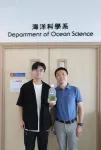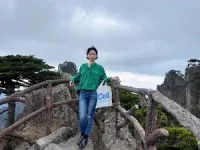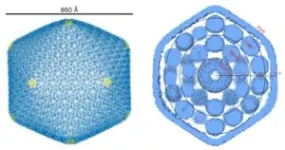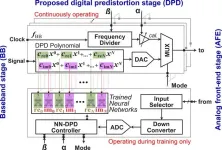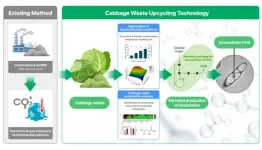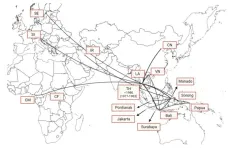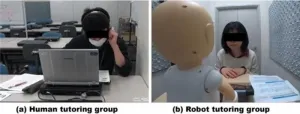(Press-News.org) A research team led by the Hong Kong University of Science and Technology (HKUST) has discovered how carboxysomes, carbon-fixing structures found in some bacteria and algae, work. The breakthrough could help scientists redesign and repurpose the structures to enable plants to convert sunlight into more energy, paving the way for improved photosynthesis efficiency, potentially increasing the global food supply and mitigating global warming.
Carboxysomes are tiny compartments in certain bacteria and algae that encase particular enzymes in a shell made of proteins. They perform carbon fixation, which is the process of converting carbon dioxide from the atmosphere into organic compounds that can be used by the cell for growth and energy. Scientists have been trying to figure out how these compartments put themselves together.
In their latest research, the team led by Prof. ZENG Qinglu, Associated Professor at HKUST’s Department of Ocean Science showed the overall architecture of carboxysomes purified from a type of bacteria called Prochlorococcus. In collaboration with Prof. ZHOU Cong-Zhao of the School of Life Sciences in the University of Science & Technology of China, the team overcame one of the biggest technical difficulties in cell breakage and contamination, which would prevent the proper purification of carboxysomes. The team also proposes a complete assembly model of α-carboxysome, which has not been observed in previous studies.
In specific, the team utilized the single-particle cryo-electron microscopy to determine the structure of α-carboxysome and characterize the assembly pattern of the protein shell, which looks like a 20-sided shape with specific proteins arranged on its surface. To obtain the structure of the minimal α-carboxysome with a diameter of 86 nm, they collected over 23,400 images taken from the microscope at the HKUST Biological Cryo-EM Center and manually picked about 32,000 intact α-carboxysome particles for analysis. Inside, the RuBisCO enzymes are arranged in three concentric layers, and the research team also discovered that a protein called CsoS2 helps to hold everything together inside the shell. Finally, the findings suggest that carboxysomes are put together from the outside in. This means that the inside surface of the shell is strengthened by certain parts of the CsoS2 protein, while other parts of the protein attract the RuBisCO enzymes and organize them into layers.
One of the most promising application of carboxysome is in plant synthetic biology, whereby the introduction of carboxysome into plant chloroplasts as the CO2-concentrating mechanism can improve photosynthetic efficiency and crop yield. “Our study unveils the mystery of α-carboxysome assembly from Prochlorococcus, thus providing novel insights into global carbon cycling,” says Prof. Zeng. The findings will also be important to slow down global warming, he says, as marine cyanobacteria fix 25% of global CO2. “Our understanding of the CO2 fixation mechanism of marine cyanobacteria will enable us to improve their CO2 fixation rate so that more CO2 can be removed from the atmosphere,” he says.
Following this study, the team plans to introduce Prochlorococcus α-carboxysome into plant chloroplasts and investigate whether the minimal α-carboxysome can improve the photosynthetic efficiency in plants. They also plan to modify the carboxysome genes and make genetically modified super cyanobacteria that are able to fix carbon dioxide at very high rates, which may be able to slow down global warming.
The study was recently published in the scientific journal Nature Plants.
END
HKUST researchers throw new light on carboxysomes in key discovery that could boost photosynthesis
2024-05-10
ELSE PRESS RELEASES FROM THIS DATE:
Learning the imperfections: a new approach to using neural networks for low-power digital pre-distortion (DPD) in mmWave systems
2024-05-10
In the world around us, a quiet but very important evolution has been taking place in engineering over the last decades. As technology evolves, it becomes increasingly clear that building devices that are physically as close as possible to being perfect is not always the right approach. That’s because it often leads to designs that are very expensive, complex to build, and power-hungry. Engineers, especially electronic engineers, have become very skilled in using highly imperfect devices in ways that allow ...
Worker rights are one of the least protected human rights, new research reveals
2024-05-10
BINGHAMTON, N.Y. -- Worker rights are among the least protected human rights in the world, according to new research from faculty at Binghamton University, State University of New York.
The findings are part of a new report published by the CIRIGHTS Data Project, the largest human rights dataset in the world. Since 1981, the project has ranked countries around the world on their respect for human rights, providing an annual “report card” on 25 internationally recognized human rights. The project ...
Unveiling crucial virulent milRNAs implicated in the initial infection of Fusarium oxysporum f. sp. cubense
2024-05-10
Fusarium oxysporum f. sp. cubense (Foc) is a typical soil-borne fungus that causes Fusarium wilt by infecting the roots and blocking the vascular tissues of host banana, and threatens the global banana production. Total four races have been reported in Foc, of which the tropical race 4 (TR4) is the most widespread race. In some severely affected banana plantations, the conventional ‘Cavendish’ variety had to be abandoned for other alternative crops due to the spread of TR4. Therefore, a comprehensive understanding of the pathogenesis of FWB and the development ...
Developing an efficient host-vector system for a model archaeon by solving CRISPR-based host-plasmid conflict
2024-05-10
This study is led by Prof. Qunxin She (Shandong University) and Dr. Guanhua Yuan (Shandong University). The research group has constructed versatile genetic tools for Saccharolobus islandicus REY15A, one of the very few archaeal models for archaea biology and CRISPR biology research, and these include efficient genome editing, robust protein expression systems, interference plasmid assay, gene silencing and CRISPR-based gene editing. Nevertheless, plasmid vectors constructed for this crenarchaeon thus far are based solely on the pRN2 cryptic plasmid. “A dual host-vector system is required to enrich the genetic toolbox for this model archaeon.” the ...
Development of technology for producing bioplastics from agricultural and food byproducts by the World Institute of Kimchi
2024-05-10
As kimchi has been drawing attention as a global healthy food trend, cabbage is one of the representative vegetables used as a main ingredient for manufacturing kimchi overseas.
The annual global production of cabbage and other Brassica crops is reported to be 72 million tons, and more than 30% of them are estimated to be discarded during the manufacturing and distribution processes, causing environmental pollution as well as considerable waste disposal costs in the industry.
In connection with this problem, Hae Choon Chang, President of the World Institute of Kimchi (WiKim), a government-funded research institute under the Ministry of Science and ICT, announced on April 22 that ...
How the brain is flexible enough for a complex world (without being thrown into chaos)
2024-05-10
Every day our brains strive to optimize a trade-off: With lots of things happening around us even as we also harbor many internal drives and memories, somehow our thoughts must be flexible yet focused enough to guide everything we have to do. In a new paper in Neuron, a team of neuroscientists describes how the brain achieves the cognitive capacity to incorporate all the information that’s relevant without becoming overwhelmed by what’s not.
The authors argue that the flexibility arises from a key property observed in many neurons: “mixed selectivity.” While many neuroscientists used to think each cell had just one dedicated function, more recent evidence ...
Tracing HIV in Indonesia
2024-05-10
The HIV variant dominant in Indonesia was introduced from Thailand over multiple events. The Kobe University study traces where it came from and how it spread from there, offering insights of possible value to the development of treatments against the disease.
HIV is the virus causing AIDS, but one of the things that make it so difficult to treat is that there are many variants of it. Kobe University virologist KAMEOKA Masanori says, “The diversity is increasing every day and the prevalent virus strains differ from region to ...
Metabolism of autism reveals developmental origins
2024-05-10
Researchers at the University of California San Diego School of Medicine have shed new light on the changes in metabolism that occur between birth and the presentation of autism spectrum disorder (ASD) later in childhood. The researchers discovered that a small number of biochemical pathways are responsible for the majority of these changes, which could help inform new early detection and prevention strategies for autism.
“At birth, the physical appearance and behavior of a child who will develop autism over the next few years are indistinguishable from that of a neurotypical child. Indeed, in most cases the fate of the child with regard to autism is not ...
Comparative analysis of robot-assisted language learning systems and human tutors in English conversation lessons
2024-05-10
Advancements in large language models, robotics, and software such as text-to-speech, have made it possible to develop robots that can understand language, interact physically, and communicate verbally. These breakthroughs have opened up possibilities for robots to be used for educational purposes. However, this raises the question of whether robots are as good as human tutors. While robots offer certain benefits, they cannot replicate the nuanced interactions and personalized feedback human tutors provide.
To determine the suitability of using ...
Under 4-minute milers’ longevity shows that extreme exercise doesn’t seem to curb lifespan
2024-05-10
Extreme exercise doesn’t seem to shorten the lifespan as is widely believed, suggest the findings of a study on the longevity of the first 200 athletes to run a mile in under 4 minutes, and published online in the British Journal of Sports Medicine.
They outlive the general population by several years, shows the study, which marks the 70th anniversary of the seminal achievement of Roger Bannister, who was the first person to run a mile in under 4 minutes in May 1954.
While regular moderate exercise is considered a pillar of healthy ageing, ...
